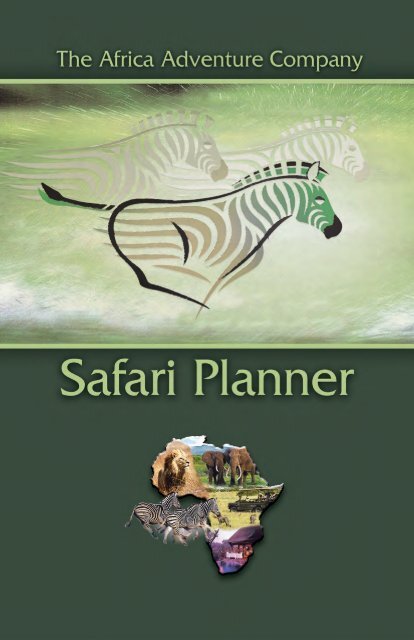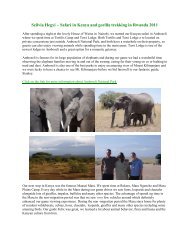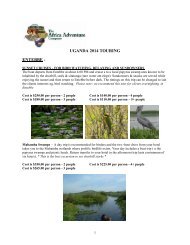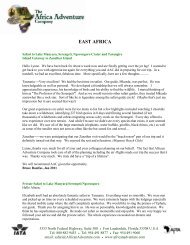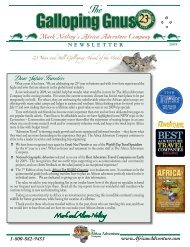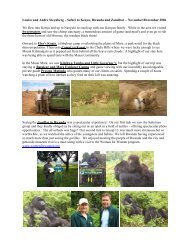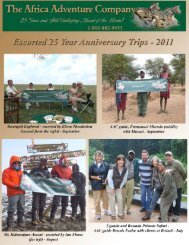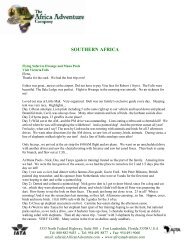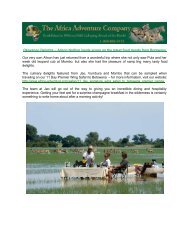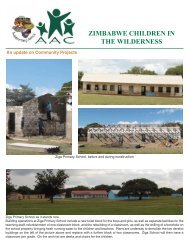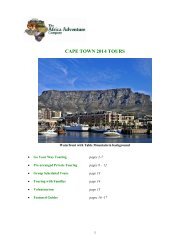Download - The Africa Adventure Company
Download - The Africa Adventure Company
Download - The Africa Adventure Company
- No tags were found...
You also want an ePaper? Increase the reach of your titles
YUMPU automatically turns print PDFs into web optimized ePapers that Google loves.
ACCOMMODATIONSANDSAFARI STYLESLounge setting of a camp or lodge, designed with local materials.<strong>The</strong>re is great variety and levels of comfort in accommodation available in the majorcities and while on safari. <strong>The</strong> type of accommodation included in a tour of <strong>Africa</strong> will havea major influence on your safari experience. Options include hotels, lodges, small campswith chalets or bungalows, houseboats, permanent tented camps and mobile tented safaris.An important factor to consider when choosing accommodations, is the size of thelodge or camp. In general, guests receive more personal attention at smaller lodges andcamps than at larger ones.• Lodges that range from comfortable to deluxe (many have swimming pools) arelocated in or near most parks and reserves. Many lodges and camps are located inwildlife areas at3,000 feet (915 m)or more abovesea level, soair-conditioningoften is notnecessary.• <strong>The</strong>re isoften confusionDining on the edge of Ngorongoro Crater.5
SAFARI ACTIVITIESAn <strong>Africa</strong>n safari can be experienced in a myriad ways–all exciting!Most often, game viewing is best accomplished in the early mornings and late afternoonswhen wildlife is most active and the lighting is more photo-friendly. Your guideplans these outings to usually last 3 to 5 hours. Depending on the park or reserve, yourguide will take you on morning or afternoon game drives in search of wildlife. In somereserves you also may take night game drives to explore the world of nocturnals. Othergame viewing options are approaching animals from the water by boat or canoe, takinggame walks, riding on elephant or horse back, or in a hot air balloon.You can take a break from pursuing wildlife and still be active. Consider the invigoratingoptions of white-water rafting, kayaking and fishing; climbing and hiking mountaintrails; visiting tribal villages and beautiful beach resorts or touring in the larger cities.4WD Open-sided vehicle, East <strong>Africa</strong>.Game viewing by vehicleOpen vehicles usually have no side, rear windows or permanent roof, providingunobstructed views in all directions. <strong>The</strong>y’re used in Botswana, Zambia, Zimbabwe,Namibia, Malawi, parts of Tanzania, and private reserves in South <strong>Africa</strong> and Kenya.Roof hatch or poptop vehicles are used in Kenya, Tanzania, Uganda and Namibia;passengers stand up through the hatch for ease of viewing and photography.Closed vehicles are more restrictive, limiting your experiences to window viewing.<strong>The</strong>se vehicles are used on group road safaris in some national parks in South <strong>Africa</strong>and Namibia and by people doing self-drive safaris.8
Open 4WD vehicle in Linyanti, Botswana.Roof hatch vehicle, Tanzania.Tracking black rhino in Zimbabwe.Game viewing by boatBoating safari along Chobe River.Canoe, mokoro (dugout canoe) and motor boats are excellent for game viewing.Elephant, buffalo and many other species that drink at the water’s edge may beapproached up close by boat. <strong>The</strong>se excursions occur in Zimbabwe, Botswana, Zambia,Malawi, Tanzania, Uganda, Ethiopia and Namibia.9
Game viewing on footA walking safari is the ultimate way to experience the <strong>Africa</strong>n bush. <strong>The</strong> thrill ofwalking up to a bull elephant, black rhino or gorillas is exciting beyond words. Anexpert guide can help you identify birds, flowers, trees and wildlife. You will even learnhow to track animals by their spoor (footprints). Walking safaris are available inZimbabwe, Zambia, Botswana, South <strong>Africa</strong> and parts of Namibia, Kenya, Tanzania,Uganda and Rwanda.SAFARI ACTIVITIESVehicles • Night Game Drives • Walking Safaris • Boat Safaris • Canoe Safaris10
TOP AFRICAN WILDLIFE COUNTRIES<strong>The</strong> top <strong>Africa</strong>n wildlife countries include Botswana, South <strong>Africa</strong>, Namibia, Zambia,Zimbabwe, Tanzania, Kenya, Uganda and Rwanda. <strong>The</strong> type and quality of safari variesgreatly from country to country, and even from park to park within the same country.In recent years Botswana has earned a reputation as perhaps the finest safaridestination in <strong>Africa</strong> – offering a pristine, exclusive, uncrowded wilderness experience.South <strong>Africa</strong> is the leader in providing the highest level of food, service andaccommodations. Many Americans have caught on to this and are vacationing in this“World Within One Country.”In addition to wildlife, Namibia has some of the most spectacular desert scenery inthe world. It is famous for its stark beauty, diversity of tribes, and it is a geologist’s andnaturalist’s paradise.Zambia has small, personal safari camps offering a variety of active options,including walking and night drives in remote parks.Zimbabwe is the best country for escorted walking and canoe safaris, and sharesmagnificent Victoria Falls with Zambia. It’s one thing to be driven up to an elephant, itis a completely different experience to walk and/or canoe up to one!In Tanzania, between <strong>Africa</strong>’s highest mountain (Kilimanjaro) and <strong>Africa</strong>’s largestlake (Victoria) lies one of the best game viewing areas on the continent. This region alsoincludes the world’s largest unflooded intact volcanic caldera (Ngorongoro) and themost famous wildlife park (the Serengeti), as well as Maasai and Bushmen tribes.Kenya is well known for the magnificent Serengeti Migration (shared with Tanzania)of more than one million wildebeest and zebra in the Maasai Mara. <strong>The</strong> culture of theMaasai, Samburu and other tribes contribute to making this a top safari destination.Uganda and Rwanda are well known as the best destinations for trekking to seeendangered mountain gorillas – one of the most exciting adventures available in all of <strong>Africa</strong>!Mozambique, Madagascar and Ethiopia are emerging destinations for travelers.A microlight above Victoria Falls provides the ultimate view.11
14EAST AND CENTRALAFRICA
SOUTHERNAFRICAPhoto credits: Nigel Robey, Wilderness Safaris, And Beyond, Nomad Safaris, Ranger Safaris, Nick Murray,Rahn Huffstutler, Kathy Berry, Tom Saville, Suyan - Asilia Lodges and Camps, Pilar Freixanet, Gene Covey,Warren Yu, Krysanthe Dawes, Randy Fowler, Ricardo Maitsch, Andre Steynberg, Mike Meyers, Rebecca Dunn,Paul Brown, Nic Polenakis, Chiawa, Wolwedans-Dune Camp, Dana Allen-Wilderness Safaris, Angela Chace,Singita.15
TANZANIASet between the tropical Indian Ocean and the two arms of the RiftValley, Tanzania is one of <strong>Africa</strong>’s most scenically beautiful countries.It also has some of the most extensive protected areas including thefabled Serengeti. <strong>The</strong> landscape rises from sea level to 19,340 feet(5,894 m) at the summit of Mt. Kilimanjaro. Covering 365,000-squaremiles(945,000-km2), Tanzania is about the same size as Texas andOklahoma combined. <strong>The</strong> population numbers some 36 million,with Dodoma as the administrative capital. <strong>The</strong> famous port city ofDar-es-Salaam has been a key trading center for centuries.KiSwahili is the most widely spoken language, but English is alsocommonly used. Currency is the Tanzanian Shilling.16
Top left: Mahale chimp; Luxury mobiletenting; Lions and Cape buffalo in theNgorongoro Crater; <strong>The</strong> dining tent at aSeasonal Camp, Serengeti; Visiting with thelocal Maasai children.Best Time to Go(Serengeti) (Ngorongoro) (Tarangire, Selous and Ruaha)Excellent: Year-round Excellent: Year-round Excellent: Jul-Oct Good: Nov-DecFair: Jan-Feb, Jun19
KENYAFrom the warm tropical waters of the Indian Ocean to the icyheights of Mount Kenya at 17,058 feet (5,199 m), this is truly “ aworld in one country”. Desert and arid savannah prevail in thenorthern frontier and southeast, while remnant forests extendover the high country and wetter west. Northern Kenya offersfacinating opportunities to spend time with primative, remotenomadic tribes. Covering 225,000-square-miles (582,750-km2),Kenya is about the same size as Texas or France. <strong>The</strong> populationnumbers some 33 million, with over 2.5 million in the capitalcity of Nairobi. KiSwahili and English are the official languages.Currency is the Kenyan shilling.20
KENYAA little lion cub takes a break from playing with its siblings.Great historical figures such as <strong>The</strong>odore Roosevelt and Ernest Hemingwayimmortalized this country. Out of <strong>Africa</strong> and other films have romanticized andperpetuated the safari mystique.Among the top safari countries, Kenya has abundant wildlife and one of the mostdiversely majestic landscapes on the continent. Lodge safaris are generally less expensivehere than in Tanzania. Flying, mobile tented, walking and horseback safaris also areavailable. Many of the private reserves cater to a maximum of 12-24 guests in luxuryaccommodations and offer activities not allowed within the parks, such as excursionsin open vehicles, night game drives and escorted walks.In the national parks you may view game in vehicles with roof hatches or poptops.Booking a safari with a private vehicle and guide is a great way to maximize the qualityof your game-viewing experience. Other activities include hot air ballooning, mountaineering,scuba diving, freshwater and deep sea fishing, and relaxing at beach resorts.MAASAI MARA NATIONAL RESERVE <strong>The</strong> finest reserve in Kenya is host to mostall of the big game. It is one of the best parks in <strong>Africa</strong> to see lion, leopard and cheetah,as well as elephant, buffalo and giraffe. Between August and October (approximately) agood portion of the Great Serengeti Migration of more than 1,000,000 wildebeest and400,000 zebra migrates into this region.21
AMBOSELI NATIONAL PARK <strong>The</strong> spectacular backdrop of Mt. Kilimanjaro isone of the real attractions here. This may be the best park in Kenya to seeelephant. Nearby are Ol Donyo Waus and Campi Ya Kanzi, private game reserves setin the foothills of the Chyulu Range. On a clear day you may see Mt. Kilimanjarofrom the lodges.SAMBURU NATIONALRESERVE This relativelysmall (40 sq. mi.) northernreserve has a number ofwildlife species not usuallyfound in the southern gameparks, including Beisa oryx,reticulated giraffe andSomali ostrich.LAIKIPIA Located north ofthe Aberdares and northwestof Mt. Kenya, this is a wild andMigration scene in the Maasai Mara, Kenya. sparsely populated region,considered to be the gateway to Kenya’sNorthern frontier. Much of Laikipia iscovered by private and communityowned ranches. <strong>The</strong> community ranchesare great places to learn about traditionalcultures. A visit to one of the privateranches is highly recommended as a wayto get off the beaten path.LEWA DOWNS A 40,000-acreprivate reserve that is home to a diversearray of wildlife and some of Kenya’smost spectacular scenery. Camel safarisare offered in the area.ABERDARE NATIONAL PARK In thisluxuriant forest, guests of two of thefamous tree hotels (Treetops and <strong>The</strong> Ark)view wildlife that congregates around thefloodlit water holes.Balloon Safari over the Maasai Mara.22
Learning about the Maasai culture is quite intriguing.TSAVO NATIONAL PARK One of the largest parks in <strong>Africa</strong>, Tsavo is split into twosectors of East and West covering a total area of over 8,000 square miles. <strong>The</strong> Easternpart is desert bush and scrub, broken up by scraggly hills. <strong>The</strong> Taita Rukinga WildlifeConservancy offers opportunities for volunteer research work.KENYA COAST <strong>The</strong> Old Harbor of Mombasa is a haven for dhows carrying goodsfor trade between Arabia and the Indian sub-continent. Excellent beach hotels arefound north and south of Mombasa. Further up the coast, the Malindi-Watamu MarineNational Reserve offers good diving and snorkeling.Best Time to GoExcellent: Dec-Mar, Jul-Sep Good: Oct, Nov Fair: JunClass A tent in the Mara.Cheetah in Swahili is “Duma.”23
UGANDA and RWANDAStradding the equator, UGANDA is a verdant country once referred toas the “Pearl of the British Empire in East <strong>Africa</strong>”. Approximately the sizeof Oregon, Uganda covers 93,000-square-miles. Almost all of the 27 millionpopulation are either subsistence farmers or employed in agriculture.Kampala is the capital city; KiSwahili and English are the main languages.RWANDA is characterized by rolling hills and volcanic peaks with altitudesvarying from 3,960 feet to 14,786 feet above sea level. Although the countrycovers only 10,160-square-miles it has a population of close to 10 million,making it one of the most densely populated countries in the world.Kinyarwanda is the predominant language, while French and English arewidely spoken.24
BOTSWANABotswana is dominated by the great Kalahari Desert which is actuallya varied landscape of grasslands, bush scrub and savannah. In thefar northwest, the Okavango River spills out onto the deep Kalaharisands to create the magical Okavango Delta - one of the continent’sgreat wilderness regions. At some 224,606-square-miles (581,730-km2) Botswana is about the size of Texas (or France). <strong>The</strong> averageelevation is around 3,200 feet (1,000 m) above sea level.Botswana’s population numbers some 1.6 million, with the greatmajority living in the southeast, including the capital cityof Gaborone. Setswana and English are the official languages.Currency is the Pula.28
BOTSWANA<strong>The</strong> beauty of the Okavango Delta.<strong>The</strong> bestsellers <strong>The</strong> Cry of the Kalahari and <strong>The</strong> No.1 Ladies Detective Agencyalong with feature stories in National Geographic and numerous documentaries havegiven Botswana international recognition as a top safari destination. <strong>The</strong> combinationof good wildlife, uncrowded reserves, small camps (chalets or tented, most 8-20 beds),with great food and the use of open vehicles for game viewing make this a destinationwell worth considering. You can view game by open vehicle (during the day and atnight), by boat, canoe, mokoro (dug-out canoe) or elephant-back. Some walkingsafaris are offered outside the reserves. Flying safaris and mobile tented camp safaris(from participatory to luxury) are also available.OKAVANGO DELTA <strong>The</strong> Okavango is the largest inland delta in the world (over6,000 square miles). This “water in the desert” phenomenon has created a unique andfascinating ecosystem well worth exploring. Activities include game drives, mokoro(dugout canoe), canoe and boat game viewing, and walking. <strong>The</strong> Delta has a highconcentration of predators (lion, leopard, cheetah), excellent bird life, hippos,crocodiles, sitatunga and other species.MOREMI WILDLIFE RESERVE <strong>The</strong> most diversified and possibly the mostbeautiful reserve in Botswana. Moremi is located in the northeastern part of theOkavango Delta. <strong>The</strong> park contains more than 1,100 square miles of permanentswamps, islands, flood plains, forests and dry land. Rhino have been reintroducedin the area, affording the possibility of seeing the “Big Five.”29
LINYANTI <strong>The</strong> Linyanti issituated northeast of theOkavango Delta and northwestof Chobe. <strong>The</strong> Linyanti Riverbecomes the Chobe River.Private concessions in this area,Linyanti, Kwando and Selinda,offer day and night game drives,walking and boating activities.CHOBE NATIONAL PARKThis park is famous for its hugeelephant and buffalo populations.Open vehicle and boat safarison the Chobe River areMother lion transporting her baby cub. offered.SAVUTE An arid region that is located in the southern part of Chobe National Park,the Savute has diverse landscapes ranging from sandveld to mopane forest, acaciasavannah, marshlands (usually dry) and rocky outcrops. Game viewing is by open vehiclein the park, which seasonally is home to a large lion and elephant populations.CENTRAL KALAHARI DESERT AND MAKGADIKGADI PANS <strong>The</strong> Central KalahariGame Reserve has an abundance of wildlife during the rainy season (December to April).Makgadikgadi Pans Game Reserve was once a large lake but eons ago became salt plainsinterspaced with grasslands and islands of vegetation, baobab and palm trees. This areais nearly devoid of human habitation and completely isolated.TULI GAME RESERVELocated in southeasternBotswana, this reserve hasabundant wildlife. Day andnight game drives, horsebackriding, mountain bikingand escorted walks are offered.Best Time to Go(Most Reserves)Excellent: Jun-OctGood: Apr, May, NovFair: Dec-MarCentral Kalahari:Excellent: Dec-AprGood: May, Jun Fair: NovMakgadikgadi Pans.30
Lilac-breasted roller.A favorite bird often seen on safari.Jao Camp.Many stories are shared around the campfire.A typical bedroom of a small permanent tented camp.31
ZIMBABWEZimbabwe is a scenic land consisting of a central plateau whichdrops down to the Zambezi and Limpopo River valleys in thenorth and south respectively. <strong>The</strong> average altitude is about 3,300feet (1,000 m) on the plateau, rising to 8,000 feet (2,440 m) in theEastern Highlands. <strong>The</strong> plateau is dominated by brachystegia(miombo) woodland, with acacia and mopane savannah in thelarger valleys. A mosaic of grassland and forest occurs in theEastern Highlands. With an area of 150,872-square-miles(390,759-km2), Zimbabwe is about the size of California (or GreatBritain). <strong>The</strong> population is estimated at 11.5 million, with thecapital of Harare having some 2 million inhabitants. Shona,Ndebele and English are the main languages. Currency is theU.S dollar.32
ZIMBABWEA close encounter with elephants during a canoeing safari.Zimbabwe has excellent and well-maintained parks and reserves. Many safari campsoffer high-quality, personalized guiding, and the country boasts the greatest variety ofmethods to view wildlife in <strong>Africa</strong>. You can view game by open vehicle during the dayand at night, walk with a licensed guide in all game parks and take boating excursions.Other activities include canoeing, kayaking and white-water rafting on the ZambeziRiver. Accommodations vary from small lodges, fixed tented camps, wildernesshouseboats and remote mobile tented safaris.MANA POOLS NATIONAL PARK Extending along the Zambezi River, Mana Poolsis the best park in <strong>Africa</strong> for both canoeing and walking safaris, plus world-class gamedrives. Prime game viewing occurs May - October. Prominent species includeelephant, buffalo, lion, <strong>Africa</strong>n wild dog, waterbuck and greater kudu. Leopard mayalso be seen.HWANGE NATIONAL PARK Zimbabwe’s largest national park is famous for itslarge herds of elephant. Predominant species also include rhino, buffalo, giraffe,zebra, wildebeest, lion, wild dog and bat-eared fox. This is one of the best parks onthe continent to see sable antelope. Waterholes (fed by wells) provide year-round forwildlife and excellent game viewing opportunities.VICTORIA FALLS In the face of a phenomenon twice the height of Niagara Fallsand one and half times as wide, one is in awe. In his journal, David Livingstone wrote“...Scenes so lovely must have been gazed upon by angels in flight.”33
<strong>Africa</strong>n wild dog.Lion can be tracked on a walking safari.Walking with a Professional Guide in Mana Pools.35
ZAMBIAZambia is one of <strong>Africa</strong>’s least developed countries, with vastareas of wilderness and a comprehensive network of nationalparks protecting its wildlife. <strong>The</strong> landscape is an upland plateauranging in altitude from 3,000 to 5,000 feet above sea level (915 to1,525 m) with dry savannah and miombo woodland predominating.Zambia’s economy is based on copper mining, agriculture andtourism. At 290,586-square-miles (752,614-km2), Zambia is largerthan Texas (or France), but has a population of some 11 million.Lusaka is the capital city with 1.3 million inhabitants. English isthe official language, with Bemba, Tonga, Ngoni and Lozi widelyspoken. Currency is the Zambian Kwacha.36
ZAMBIABoating on the Lower Zambezi river.Zambia is blessed with some of <strong>Africa</strong>’s most unspoiled wildlife areas featuringwell- established safari operations that specialize in small lodges and permanent tentedcamps. Activities include walking safaris lasting from a few hours in the morning toseveral days, day and night game drives, canoeing and white-water rafting.SOUTH LUANGWA NATIONAL PARK This floodplain ecosystem supports a varietyof wildlife, including puku, impala, zebra, eland, wildebeest, buffalo, elephant, lion andhyena. Night game drives often provide sightings of leopard, mongoose, hyena, jackal,civet and genet. Many of the bush camps offer multi-day walking safaris.NORTH LUANGWA NATIONAL PARK Remote walking safaris are the mainattraction here. Limited day and night game drives are also available.LOWER ZAMBEZI NATIONAL PARK Bordered on the south by the Zambezi River,this park offers canoeing and boating, walking and night and day game drives.KAFUE NATIONAL PARK A large park supporting a variety of interesting species,including lion, leopard, sable, red lechwe and greater kudu. Cheetah are found on theBusanga Plains.VICTORIA FALLS/LIVINGSTONE Victoria Falls’ Eastern Cataract and Boiling Potcan be viewed from the Knife Edge Bridge.Best Time to Go Excellent: Jul-Oct Good: May, Jun, Nov Fair: Dec-AprZebras in Kafue National Park.Walking Safari in South Luangwa.37
NAMIBIANamibia is one of <strong>Africa</strong>’s driest countries, with the Namib andKalahari Deserts dominating the landscape. Elevation ranges fromsea level on the Atlantic seaboard to some 5,410 feet (1,650 m) atWindhoek on the central plateau. In the far north, the permanentwater of the Kunene and Okavango Rivers allows for productiveagriculture and it is here that most of the population lives. Justover two million people inhabit the 318,250-square-miles (824,268-km2) of Namibia which is about the size of Texas and Oklahomacombined. Windhoek is the capital city. English is the officiallanguage. Currency is the Namibian Dollar.38
NAMIBIA<strong>The</strong> changing colors of the Namib-Naukluft Dunes.Besides the wildlife, Namibia is famous for its stark beauty. A geologist’s and naturalist’sparadise, Namibia has some of the most fascinating desert landscapes on earth.Essentially a desert land, Namibia is one of the most interesting and unusual of <strong>Africa</strong>ncountries. It may seem inhospitable in its dryness, but an astonishing variety of wildlifeexists there, including unique, desert-adapted species, together with the big game ofthe savannah. You can view game by open-sided vehicles, or walk in the desert andwilderness areas. Activities include visiting tribal villages, flying safaris to remote areas,boating and viewing rock paintings. Accommodations are in small lodges, tentedcamps and on mobile tented safaris. For scenery, the country can be visited year round.ETOSHA NATIONAL PARK Etosha is Namibia’s premier reserve for wildlife andone of the best and largest (8,600 sq. mi.) reserves in <strong>Africa</strong>. Mixed scrub, mopanesavannah and dry woodlandsurround the huge EtoshaPan, a silvery white depression,dry except during therainy season. Etosha has ahuge elephant population.Lion, cheetah and rhino areoften sighted. Adjacent tothe park is Ongava PrivateGame Reserve.Etosha waterhole scene.39
Desert lodging.NAMIB-NAUKLUFT NATIONAL PARKThis scenic park covers 19,215 square miles ofdesert, savannah grassland, gypsum andquartz plains, and granite mountains. <strong>The</strong>re isan estuarine lagoon, a canyon, and huge, drifting,apricot-colored sand dunes exceeding 1,000feet in height, at Sossusvlei. Adjacent to thepark is the NamibRand Nature Reserve.DAMARALAND/KAOKOLANDLocated inland, east of the SkeletonCoast and west of Etosha, is an aridmountainous region of spectacularrugged scenery. It is home to thedesert elephant, a large population ofblack rhino, Hartmann’s mountainzebra, desert dwelling giraffe, lion,various antelope and other species.Ballooning at Sossusvlei.Desert elephant.Dunes of Serra Cafema.40
Himba lady.Flying along the Skeleton Coast.SKELETON COAST NATIONAL PARK Skeletons of shipwrecks and whales dot thetreacherous coastline of this park, covering more than 2,000 square miles of windsweptdunes, canyons and jagged peaks of the Namib Desert. <strong>The</strong> northern part of the parkhas been designated a wilderness area and can be visited only with fly-in safaris.Serra Cafema Camp is located in the remote northern region of the Skeleton Coast.Activities include quad biking and visits to local Himba villages.Best Time to Go (for wildlife in Etosha) Excellent: Jun-Oct Good: Apr, May, NovBest Time to Go (for scenery and wildlife in other reserves) Year-roundClass A+ accommodation - Little Kulala.41
SOUTH AFRICAAt the southern end of the continent, South <strong>Africa</strong> is an extremely diversecountry with temperate highlands, subtropical savannah, alpine-likemountains, semi-desert and unique Mediterranean-like scrub lands knownas “fynbos”. Much of the country is a high plateau averaging some 4,800feet (1,500 m) above sea level, with the Drakensberg rising to 11,400 feet(3,450 m). <strong>The</strong> country is flanked by the cool Atlantic and warm IndianOceans, each of which has a strong bearing on the climate. South <strong>Africa</strong>is the most industrialized nation on the continent but still has largeprotected areas including the famous Kruger National Park and surroundingareas which occupy most of the lowveld. Covering some 471,445-squaremiles(1.2 million-km2), South <strong>Africa</strong> is twice the size of Texas. Englishis the official language, with Zulu, Tswana, Xhosa, Sotho and Afrikaansall widely spoken. <strong>The</strong> population is estimated at around 45 million.Pretoria and Cape Town are the capital cities but Johannesburg is thebusiness hub. Currency is the Rand (ZAR).42
SOUTH AFRICAScenic setting of Cape Town Harbor and Table Mountain.South <strong>Africa</strong> is a large country, rich in natural beauty and wildlife, with unspoiledbeaches, dramatic mountains, protected wilderness areas, national parks and gamereserves. Accommodations vary from deluxe safari camps and hotels to self-servicebungalows. You may view game by closed vehicle in national parks and by openvehicle and walking tours in private game reserves and wilderness areas. Self-drivetours are also available.KRUGER NATIONAL PARK AND THE PRIVATE RESERVES <strong>The</strong> most populararea in the country for wildlife safaris for international visitors are the privatereserves that lie along Kruger National Park’s western border. Game viewing in thepublic areas of Kruger National Park itself is not recommended as over 500,000tourists visit each year, onlyclosed vehicles are allowed, andoff-road driving is not allowed.Along the borders of Kruger arefound a number of privatelyowned wildlife reserves andconcession areas. Some advantagesprivate reserves have overnational parks is that they useopen vehicles, travel off road,and offer night drives and walks.<strong>The</strong>y generally have exceptionallyhigh standards of accommodation,food and service.Class A+ Lodge in a private reserve.43
MPUMALANGA AND NORTHWEST PROVINCE Located northeast and northwestof Johannesburg, there are several more private reserves that are destined to becomesome of South <strong>Africa</strong>’s new wildlife hotspots.BLUE TRAIN/ROVOS RAIL <strong>The</strong> world-renowned, deluxe Blue Train runs betweenJohannesburg and Pretoria and Cape Town to Port Elizabeth. Rovos Rail, a luxuriouslyrenovated steam train, also runs from Pretoria to Cape Town and Victoria Falls, as wellas offering trips to Namibia and Tanzania.South <strong>Africa</strong> has growing populations of both black (pictured here) and white rhino.KWAZULU (NATAL) KwaZulu-Natal is located in eastern South <strong>Africa</strong> along theIndian Ocean. <strong>The</strong> Drakensberg Mountains rise to 11,420 feet (3,482 m) and runroughly north and south along its western border, which it shares with Lesotho. <strong>The</strong>reare numerous Zulu War and Anglo-Boer War battle sites in the region, includingIsandlwana and Rorke’s Drift. Kwazulu offers well-run, uncrowded, small gamereserves, including Hluhluwe-Umfolozi, Ndumo, Mkuzi and Phinda. Phindafeatures 43,240 acres of land conservation and seven distinct habitats. Wildlife includesthe Big Five.MAPUTALAND AND ST. LUCIAMARINE AND COASTALFOREST RESERVES <strong>The</strong>sereserves combined form <strong>Africa</strong>’slargest marine conservation area.<strong>The</strong>y run along the Indian Oceancoastline from south of CapeVidal to the Mozambique border.Scuba diving experience on Maputaland coast.44
CAPE TOWN This beautiful city at the foot of Table Mountain offers fine beaches,Cape Dutch architecture, vineyards, and botanical gardens. This is one of the mostbeautiful cities in the world to visit any time of the year. Northwest and east of CapeTown are attractions that easily rival those on the more well-known Garden Route.Fabulous mountain scenery, whale and birdwatching along the stark AtlanticCoastline, and the magnificent proliferation of flowers in August and September, makethis a region well worth visiting.GARDEN ROUTE <strong>The</strong> Garden Route runs between Mossel Bay and Storms River,near Plettenberg Bay. It is lined with Indian Ocean coastal scenery, beautiful beaches,lakes, forests and mountains. Small, country hotels offer comfortable accommodations.EASTERN CAPE <strong>The</strong>re are several private game reserves and parks located outsideof Port Elizabeth. <strong>The</strong>se include Shamwari, Addo Elephant, Mkambati andKwandwe. Kwandwe is a 39,000 acre malaria-free game reserve that stretches alongthe Fish River. <strong>The</strong> Wild Coast also offers some great hiking trails.Best Time to GoWildlife: Excellent: Jul-Oct<strong>The</strong> Cape: Excellent: Oct-MarGood: Mar-Jun, Nov Fair: Dec-Feb Good: Apr-SepFood on safari is simply divine.<strong>Africa</strong>n penguins on the Cape Peninsula.Wining and dining in a Boma.45
For <strong>The</strong> Safari of a Lifetime5353 North Federal Highway, Suite 300Fort Lauderdale, Florida 33308 USATel: 800.882.9453 • 954.491.8877Fax: 954.491.9060Email: Safari@<strong>Africa</strong>n<strong>Adventure</strong>.comWebsite: www.<strong>Africa</strong>n<strong>Adventure</strong>.com


